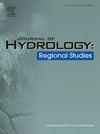An integrated modelling framework for optimization of the placement of grey-green-blue infrastructure to mitigate and adapt flood risk: An application to the Upper Ting River Watershed, China
IF 4.7
2区 地球科学
Q1 WATER RESOURCES
引用次数: 0
Abstract
Study regions
This study focuses on the Upper Ting River Watershed (UTRW) in the Ting River Basin, China.
Study focus
The study investigates the adverse impacts of urbanization and land-use change on hydrology, proposing the implementation of grey-green-blue infrastructure (GGBI) practices to mitigate these effects. An integrated modeling framework is developed to optimize the placement of GGBI, demonstrated through a case application in the UTRW.
New hydrological insights for the region
(1)The proposed modeling framework is highly effective in identifying key nodes and corridors for stormwater processes and flood inundation at both the watershed and city levels. It guides the reconstruction of GGBI spatial patterns at the watershed level and optimizes GGBI placement at the city level.
(2)In the central city, flooding covers an area of 8.44 km², or 18.53 % of the total area, with average flood depths of 0.99 m and maximum depths reaching 1.69 m. Areas most suitable for GGBI construction are located along the Ting River, showing clear continuity and concentration in the central city and Xinqiao Town.
(3)The optimized placement of GGBI, based on the SWMM model and non-dominated sorting genetic algorithm (NSGA-III), effectively reduces flood damage. Multi-objective optimization solutions outperform alternatives in terms of runoff reduction, pipeline overload duration, and construction costs.
求助全文
约1分钟内获得全文
求助全文
来源期刊

Journal of Hydrology-Regional Studies
Earth and Planetary Sciences-Earth and Planetary Sciences (miscellaneous)
CiteScore
6.70
自引率
8.50%
发文量
284
审稿时长
60 days
期刊介绍:
Journal of Hydrology: Regional Studies publishes original research papers enhancing the science of hydrology and aiming at region-specific problems, past and future conditions, analysis, review and solutions. The journal particularly welcomes research papers that deliver new insights into region-specific hydrological processes and responses to changing conditions, as well as contributions that incorporate interdisciplinarity and translational science.
 求助内容:
求助内容: 应助结果提醒方式:
应助结果提醒方式:


